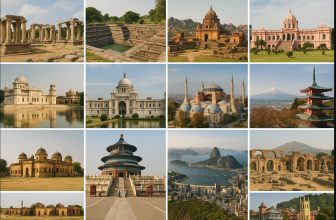India’s history is filled with ambitious architectural projects, many of which became world-famous landmarks. However, not all grand visions reached completion. Some monuments were abandoned mid-construction due to wars, political changes, economic constraints, or the deaths of their patrons. These unfinished structures, though incomplete, still stand as testaments to India’s rich architectural heritage and lost ambitions.
Had these monuments been completed, they could have rivaled some of the greatest wonders of the world, reshaping the country’s historical and cultural landscape. From Alauddin Khilji’s towering aspirations to Mughal emperors’ unrealized dreams, these monuments remain frozen in time, whispering stories of what could have been.
In this list, we explore 11 unfinished Indian monuments that were meant to be grand wonders, revealing the fascinating stories behind their abandonment and what remains of them today.
1. Alai Minar (Delhi) – A Tower Meant to Surpass the Qutub Minar
Sultan Alauddin Khilji envisioned a colossal victory tower, intended to be twice the height of the Qutub Minar. It was planned as a symbol of his military dominance.
Why It Was Left Incomplete
After Alauddin Khilji’s death in 1316, the construction halted as his successors lost interest in the project. Only the first storey (24 meters high) was completed.
What Remains Today
A gigantic, unfinished stone stump stands within the Qutub Minar complex, offering a glimpse into Khilji’s grand but unrealized ambition.
2. Bibi Ka Maqbara (Aurangabad) – The ‘Taj Mahal That Never Was’
Commissioned by Aurangzeb in memory of his wife, Bibi Ka Maqbara was meant to rival the Taj Mahal, built by his father, Shah Jahan.
Why It Was Left Incomplete
Aurangzeb allocated far fewer resources, resulting in a smaller and less refined version of the Taj Mahal, built with cheaper materials.
What Remains Today
A scaled-down imitation of the Taj Mahal, lacking the grandeur and intricate marble craftsmanship of its inspiration.
3. Martand Sun Temple (Jammu & Kashmir) – A Grand Temple Destroyed Before Completion
Built by Lalitaditya Muktapida in the 8th century, the Martand Sun Temple was planned as one of the most magnificent Hindu temples, dedicated to the Sun God.
Why It Was Left Incomplete
In the 14th century, Sultan Sikandar Butshikan led an attack on Hindu temples and partially demolished the structure before it was completed.
What Remains Today
A sprawling stone ruin set against the breathtaking Kashmir valley, showcasing the architectural brilliance that was tragically cut short.
4. Fatehpur Sikri (Uttar Pradesh) – The Grand Mughal Capital That Was Abandoned
Emperor Akbar built Fatehpur Sikri in the late 16th century, intending it to be the new Mughal capital, with elaborate palaces, mosques, and gardens.
Why It Was Left Incomplete
Severe water scarcity made the city uninhabitable, leading to its abandonment within just 15 years.
What Remains Today
A remarkably well-preserved ghost city, offering a glimpse into the once-thriving Mughal capital that never fulfilled its destiny.
5. Vijaya Stambha Expansion (Chittorgarh) – The Tower That Was Never Extended
Rana Kumbha built the Vijaya Stambha (Victory Tower) in the 15th century to celebrate Rajput valor, with plans to expand it further.
Why It Was Left Incomplete
After Rana Kumbha’s assassination, the project was abandoned, and the tower remained at its current height.
What Remains Today
A 37-meter-tall monument, symbolizing Rajput bravery but missing its intended expansion.
6. Adilabad Fort (Delhi) – The Forgotten Twin of Tughlaqabad Fort
Built by Ghiyasuddin Tughlaq, Adilabad Fort was meant to be an extension of Tughlaqabad Fort, forming a larger, interconnected defense system.
Why It Was Left Incomplete
After Tughlaq’s sudden death, his successors shifted their focus elsewhere, and the project was abandoned.
What Remains Today
An overgrown, neglected ruin, overshadowed by its larger and more famous counterpart, Tughlaqabad Fort.
7. The Unfinished Tomb of Akbar (Agra) – A Scaled-Down Memorial
What It Was Meant to Be
Akbar personally planned an opulent mausoleum for himself, which was supposed to surpass all previous Mughal tombs.
Why It Was Left Incomplete
After Akbar’s death in 1605, his son Jahangir altered the design, simplifying it.
What Remains Today
A beautiful yet simpler tomb at Sikandra, impressive but not as grand as Akbar had envisioned.
8. Halebidu Temple (Karnataka) – The Unfinished Hoysala Masterpiece
The Hoysaleswara Temple in Halebidu was intended to be one of the grandest Hindu temples ever built.
Why It Was Left Incomplete
Repeated Delhi Sultanate invasions in the 14th century halted construction, leaving it unfinished.
What Remains Today
A temple with incomplete yet breathtaking carvings, showcasing Hoysala artistry.
9. Gol Gumbaz Expansion (Karnataka) – The Dome That Never Had a Twin
Built by Mohammed Adil Shah, Gol Gumbaz was intended to have a twin dome, making it an even grander structure.
Why It Was Left Incomplete
The ruler’s death in 1656 halted construction, leaving the second dome unbuilt.
What Remains Today
A massive single dome, one of the largest in the world, but missing its planned counterpart.
10. Padmanabhapuram Palace Extension (Kerala) – The Unfinished Royal Dream
The Travancore kings planned a vast palace complex, blending Kerala’s wooden architecture with intricate courtyards and halls.
Why It Was Left Incomplete
Political shifts and the decline of Travancore rule led to the project being abandoned.
What Remains Today
A stunning yet incomplete wooden palace, admired for its ornate interiors.
11. The Unbuilt Second Parliament House (New Delhi) – The British Colonial Dream That Ended
The British planned a second Parliament House in New Delhi as part of their imperial capital expansion.
Why It Was Left Incomplete
India’s independence in 1947 halted all British architectural projects, including this one.
What Remains Today
The original Parliament House stands alone, without its intended twin structure.
Final Thoughts – Monuments That Were Never Fully Built
India is home to several unfinished monuments, each carrying a story of interrupted dreams, forgotten ambitions, and lost grandeur. Some, like the Alai Minar, were envisioned as record-breaking towers, while others, like Fatehpur Sikri, were meant to be powerful capitals before being abandoned. Temples, forts, and tombs, planned with the highest artistic and engineering standards, were left incomplete due to invasions, financial struggles, and changing dynasties.
Despite never reaching their full potential, these structures remain historically significant, providing valuable insights into India’s architectural brilliance and evolving history. Their unfinished state adds a sense of mystery and intrigue, making them captivating relics of the past.
These monuments stand as a reminder that greatness is not just in completion but also in the ambition and artistry that shaped them.





